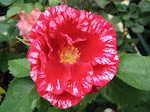First off, you should know from the get-go that I am a one-scent woman. Here’s how it happened. In my salad days, I was strolling down Robson Street in Vancouver and discovered a marvelous shop called Gallipots, now long gone. At the entrance to this diminutive treasure was an enticing display of florally scented perfumes and colognes, all made by an east coast American company – The Perfumers’ Workshop. Never before or since have I inhaled such true-to-flower scents in any perfume.
Not cloying but almost wistful, there were about ten different scents that could be purchased. I recall there were Magnolia, Gardenia, Lilac and, my favourite, Tea Rose. From the first moment I smelled this old rose aroma I was hooked and so were all those who would come in contact with me over the next three decades.

Wherever I go I can almost count on at least one person - in a crowd, at dinner, in the butcher shop, at a park – to be heard to say, “What is that wonderful scent, it smells like real roses?” Of course the problem becomes, do I enlighten them about the particular perfume I use and become less unique, or let them wander off always wondering what it was that turned a normal atmosphere into a virtual Mottisfont Abbey on a mid-June day.
I am now about to reveal my source after all these years so others, fortunate enough to cadge a bottle, can experience this fresh scent every day like me. The Perfumers’ Workshop was only able to market their amazing line of flower products for a short time and Tea Rose was ever after always difficult to find. In the early years Bloomingdales in New York could always be counted on, until recently. Now it can be discovered in discount stores like Dollars & Scents in the United States, and of course, online.
The great news is that Tea Rose by the Perfumers’ Workshop is relatively inexpensive with a 4 ounce bottle costing only about $25.
Good luck on your journey to finding what I think is the best and most authentic rose scent anywhere!
















